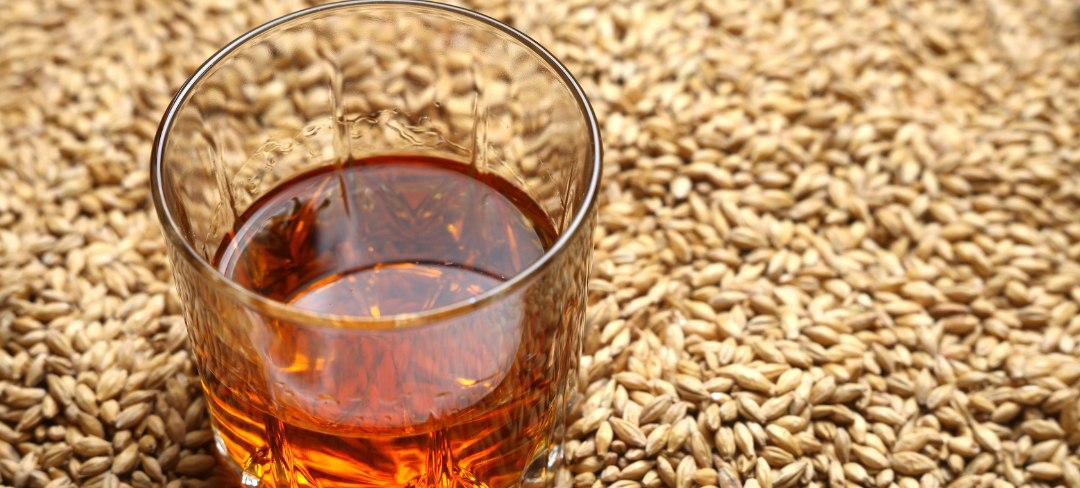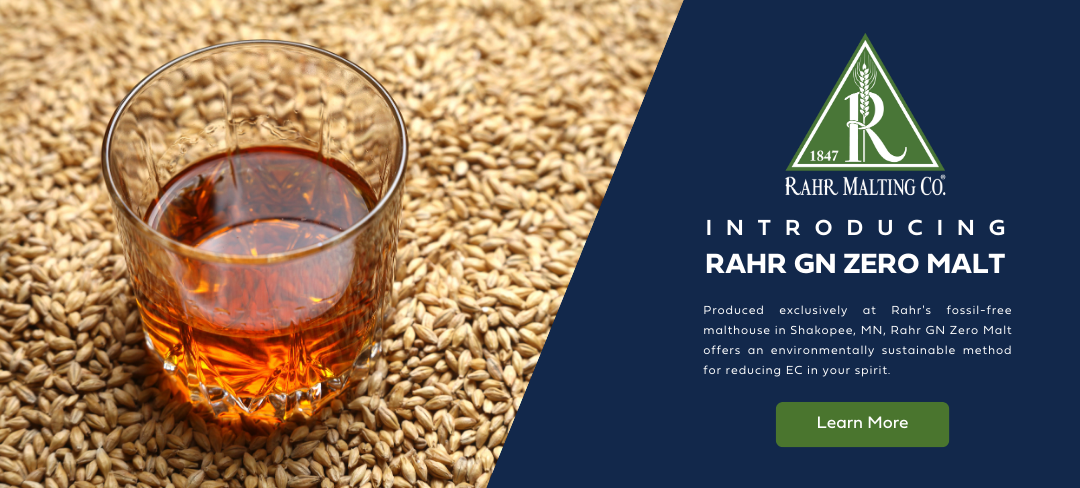Introducing Rahr GN Zero Malt for the Distiller!

Greetings, Distillers! Thank you for making your way to the RahrBSG Blog. National Marketing Manager Matt Bolling and Commercial Director Aaron Hyde are here to share all the grainy details behind Rahr GN Zero Malt, a premium distilling malt composed of Glycosidic Nitrile-free North American 2-Row barley. If whiskey gets your wheels spinning, grab a stool and keep scrolling!
Rahr GN Zero Malt is a non-glycosidic nitrile malt that contains little to no glycosidic nitrile (GN), essentially eliminating carcinogenic ethyl carbamate (EC) formation from malt in spirits.
When it comes to crafting exceptional whiskies or other grain-based spirits, the choices we make in ingredients like malt can seem small, but they can make all the world of difference. For distillers looking for future compliance, increase spirit yield, and exceptional malt flavor in their final product, Rahr GN Zero malt is the ultimate solution. It’s especially practical for those making American Single Malt Whiskey and others with a high percentage of malt in their grain bill.
Why Do We Consider Rahr GN Zero Malt a Breakthrough in the Whiskey World?
It uses a unique barley variety that has very little to no GN present. It’s also widely grown for Rahr Malting, so there is no premium on the price, something you might find on other non-GN offerings out there. Unlike other distilling malts out there, we use only premium, high-grade malting barley. This means your mash efficiency and spirit yield will be the same or better than what you’re currently getting. Wouldn’t you like more spirit from the same amount of product and effort after all that hard work? Time to switch to Rahr GN Zero malt!
What Is Glycosidic Nitrile (GN) and Why Does It Form in Barley?
Whiskey and grain distillers are becoming familiar with the risks associated with GN-containing malt, as it is a key factor in unwanted carcinogenic ethyl carbamate (EC.) Glycosidic Nitrile is a naturally occurring compound found in certain types of barley. It’s produced by the plant to stave off pests in the field. Most barley grown in North America contains GN. During fermentation, it can break down into precursors that ultimately contribute to the formation of ethyl carbamate (EC), a potentially harmful compound found in plenty of foods and beverages, but often in low levels, and monitored. In spirits the distillation process concentrates EC that ultimately ends up in your whiskey.
What Is Epoxy-Hexenal (EPH) and How Does It Form During Malting?
If GN is present, it can increase during the germination process of malting barley. EPH, or epoxy-hexenal precursors, are intermediate compounds that arise during the malting process, especially in barley varieties containing GN. During fermentation and distillation, these precursors can convert into GN and eventually lead to EC formation in the finished spirit. The malting process, which involves steeping, germinating, and kilning of barley, influences the levels of GN and EPH. The choice of barley variety, environmental factors, and malting techniques all contribute to the potential presence of these unwanted compounds. Rahr Malting is constantly studying barley varieties and malting practices that might limit these compounds, and ultimately EC in your spirit.
What is Ethyl Carbamate and How is it Formed?
Ethyl carbamate (EC) is a compound that can form during fermentation and distillation when specific chemical precursors, like GN, combine with ethanol. The formation and concentration of EC in spirit is influenced by a variety of factors, including barley variety, malting process, fermentation conditions, the presence of nitrogenous compounds such as urea during fermentation, copper interaction during distillation, and ultimately the distillation process itself.
Why Should Maltsters and Distillers Care About Ethyl Carbamate (EC)?
Though ethyl carbamate is naturally occurring in fermented foods and drinks, its potential to cause long-term health risks is a serious concern. While EC is not directly harmful in small amounts, research has shown that it is a potential carcinogen, which is why its levels in alcoholic beverages are regulated in many countries. For distillers, maintaining EC levels within regulatory limits is important, not only for product safety but also for compliance with international standards. Exceeding these limits could result in legal challenges, product recalls, and damage a brand’s reputation.
What Are Maximum Ethyl Carbamate Levels Permitted by Country?
Different countries have established maximum allowable levels of EC in alcoholic beverages. For example, some of the major markets globally look like this:
- United States: The U.S. Alcohol and Tobacco Tax and Trade Bureau (TTB) recommends that EC levels in spirits should not exceed 125 parts per billion (ppb).
- Canada: Canadian regulations limits EC to 150 ppb in distilled spirits.
- European Union: EU regulations has a limit of 150 ppb for whisky. There are specific guidelines for other beverages, and industry standards recommended to distillers to minimize EC levels in beverages.
These regulations are strictly enforced, particularly for exported products, making it essential for distillers to manage EC levels effectively. There is ongoing consideration within these countries as to how they will regulate imports as well.
What Are Mitigation Strategies for Ethyl Carbamate?
Distillers have several tools at their disposal to mitigate the formation of ethyl carbamate in spirits. The most effective strategies include:
- Using Non-GN Malt: The simplest and most impactful solution is to eliminate the source of GN altogether. Rahr GN Zero malt’s barley variety is specially bred to contain no glycosidic nitrile, thereby reducing the risk of ethyl carbamate formation at its source. This non-GN malt ensures safer distillation without sacrificing flavor or efficiency.
- Avoiding Urea in Fermentation: Urea, sometimes used as a yeast nutrient, can react with ethanol to form EC. By using alternative nitrogen sources, such as diammonium phosphate (DAP), distillers can prevent the formation of urea and reduce the risk of EC formation.
- Optimizing the Malting Process: Rahr continues to learn more about germination times, controlling kilning temperatures that can drastically minimize the levels of GN and EPH during malting.
- Still Design and Stillhouse Techniques: Distillers can also make adjustments in the still design to reduce EC formation. For example, ensuring proper copper contact in the still helps in catalyzing and breaking down harmful compounds that contribute to EC formation. There are further studies ongoing about optimizing reflux and distillation temperatures that can help prevent the carryover of ethyl carbamate precursors into the final distillate as well.
Why Switch to Rahr GN Zero Malt Now?
In an industry where product safety guidelines are paramount to you and your customers, using Rahr GN Zero malt is a smart choice. It offers you future-proof spirits, and peace of mind for distillers and consumers alike, all without compromising on the quality and flavor you’re known for. The potential yield increase and cost-effectiveness makes the switch to Rahr GN Zero malt in your next batch of whiskey a no-brainer.
Chat with us to make the simple conversion to Rahr GN Zero Malt today!
